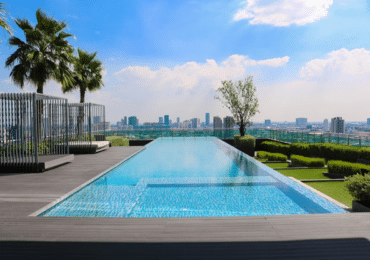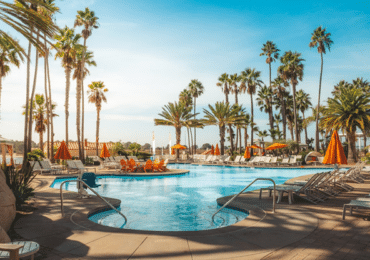Having a backyard pool can provide an excellent way to beat the summer heat, but it also requires ongoing maintenance and care. Keeping your outdoor pool operating optimally isn’t as daunting as you might think; with just a few simple tips, you’ll ensure that your swimming spot is sparkling clean and working properly year after year. In this blog post, we’ll discuss everything from proper pH levels to efficient filtration systems so that you can enjoy cool relief in your backyard all season long!

Why Not Get A Robot Cleaner To Help You Out
Are you tired of spending hours cleaning your pool every week? Why not let a robot cleaner do the work for you? With advanced technology, this type of pool cleaner is designed to efficiently and effectively clean your pool without any additional effort from you. Not only will you be able to save time, but you’ll also enjoy a cleaner and healthier pool. There’s no need to worry about maintenance either since most robot pool cleaners are designed to make cleaning and upkeep a breeze. With such an investment, you’ll have more time to enjoy your pool and relax!
Efficient Pool Filtration
The heart of your pool’s cleanliness and clarity lies within the filter system. Regardless of the type of filter your pool uses—sand, cartridge, or diatomaceous earth—regular inspection and cleaning are crucial for maintaining its efficiency. Over time, grime and debris accumulation can lead to decreased water flow and filter effectiveness, potentially leading to cloudier pool water or even damage to your pool’s circulation system.
Aim to clean your filter every few weeks during the swimming season, and always after a heavy storm. If you notice persistent issues despite regular cleaning, it might be time to consider a filter replacement. Remember, a well-functioning filter system not only ensures a sparkling clean pool but also prolongs the lifespan of your pool equipment, making for a healthier and more enjoyable swimming experience.
Maintaining Proper Water Chemistry
Proper water chemistry ensures not only a safe swimming environment but also prevents potential damage to your pool’s infrastructure. The key factors to monitor are pH, chlorine, and alkalinity levels.
The pH level determines how basic or acidic the water in your pool is. A balanced pH level should be between 7.4 and 7.6, enabling the chlorine to work effectively at killing bacteria and algae. If the pH is too high or too low, it can cause eye and skin irritation, as well as damage your pool equipment.
Chlorine is the disinfectant that keeps your pool water safe and free from harmful bacteria and algae. A chlorine concentration of 1 to 3 parts per million (ppm) is considered optimal. Ongoing maintenance and periodic shock treatments help maintain these levels.
Brushing and Vacuuming
Brushing and vacuuming are essential steps to keep your pool in pristine condition. Although your filtration system and chemical treatments play a crucial role, manual cleaning is still required to remove stubborn dirt and prevent algae growth.
Make it a practice to brush your pool walls and floor at least once a week. Use a pool brush suitable for your pool type. Stainless steel brushes work best for concrete or plastered pools, while nylon brushes are ideal for vinyl or fiberglass walls. Brushing dislodges algae and dirt, which can then be successfully removed by the filtration system.
Similarly, vacuuming your pool weekly can help remove stubborn debris that the filtration system cannot. An automatic pool cleaner can perform this task efficiently, but manual pool vacuuming gives you the chance to spot potentially problematic areas.

Managing Pool Water Levels
Maintaining the correct water level in your swimming pool is critical to its optimum operation and longevity. An underfilled pool can cause the pool pump to run dry and overheat, leading to potential damage. Conversely, an overfilled pool may result in diluted chemicals, making your pool less sanitary and safe.
Typically, the ideal pool water level is halfway up the pool skimmer’s opening or level with the center of your pool tile. This allows for proper circulation and filtration.
During hot summer days or periods of heavy usage, water levels can drop due to evaporation and splash out. Regularly monitor the water level and add water as needed to maintain the ideal level.
On the other hand, heavy rainfalls can cause the pool to overfill, disrupting the balance of chemicals. If your pool is overfilled, you may need to drain some water. Most pools have a waste or drain setting on their filter system, which you can use to lower water levels.
Cleaning and Checking Pool Equipment
Maintaining the operational efficiency of your pool equipment is as important as keeping the pool water clean. This involves routinely checking pumps, skimmers, and drains, and keeping them free from obstructions.
The pool pump is essentially the heart of your pool’s circulation system. It propels the water from the pool and sends it through the filter for debris removal. Regularly inspect the pump for leaks or unusual noises, which might be signs of wear and tear. Also, clean the pump basket weekly to eliminate debris that might hinder water flow.
Skimmers, on the other hand, are your pool’s first defense against debris. Located on the side of the pool, they draw in water and collect debris such as leaves and grass. Regularly empty and clean the skimmer baskets to optimize their functionality and ensure efficient water flow.
Addressing Algae Growth Promptly
Algae growth can be a common issue in pools, turning your water green and making the surfaces slippery. It’s essential to address any signs of algae promptly to prevent larger infestations.
To prevent algae growth, maintaining balanced water chemistry is key. Regular testing and adjusting of your pool’s pH and chlorine levels can help keep algae at bay. Additionally, consistent brushing and vacuuming of pool surfaces disrupt any algae attempting to gain a foothold.
If you notice algae in your pool, it’s time to take action. Start by brushing the pool to detach the algae from surfaces. Then, shock your pool by adding a high dose of chlorine. This kills the algae and makes it easier for your filtration system to remove the remnants. You may need to repeat this process several times for severe infestations.
In conclusion, maintaining a clean and fully functioning outdoor pool is a multifaceted process that involves regular cleaning, proper water chemistry, efficient filtration, and proactive algae control. Each of these components plays an integral role in ensuring not only a pleasant swimming experience but also the longevity of the pool and its equipment. By adhering to these recommended practices, you can enjoy a sparkling clean pool that offers endless enjoyment and serves as a centerpiece for outdoor activities.

